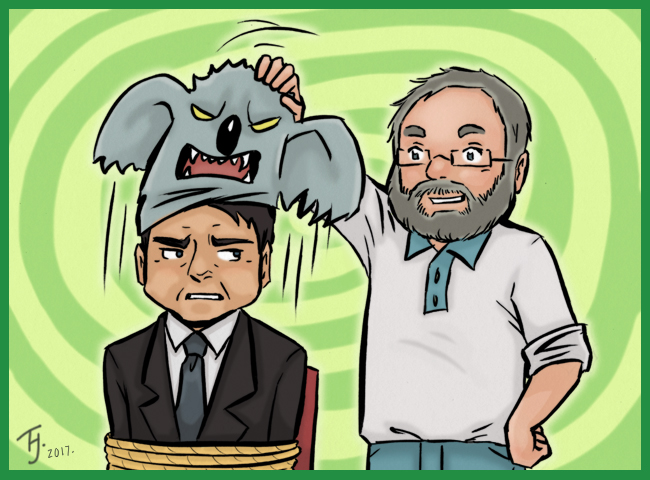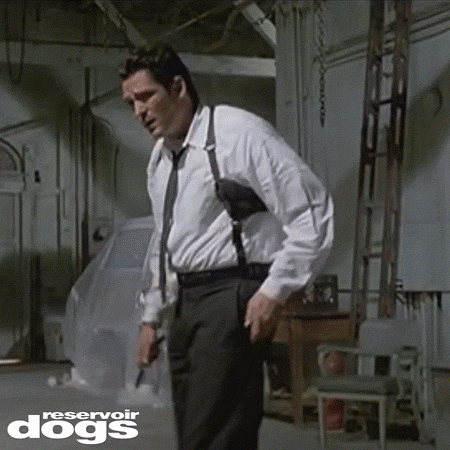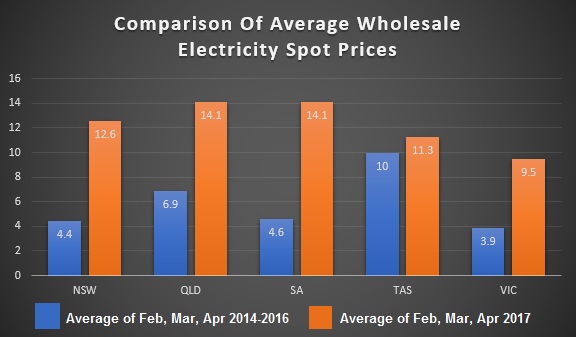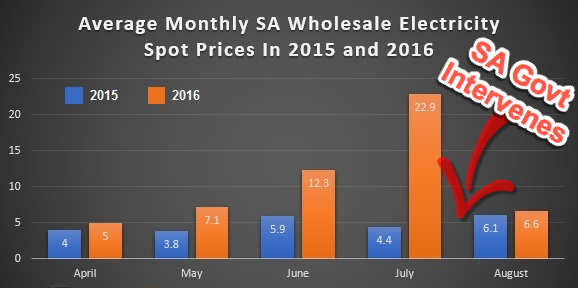
Ronald unveils the true culprit behind current electricity price rises.
Australia’s grid electricity prices are about to soar so high they’ll probably suffer from altitude sickness. Households in all states, with the possible exception of Tasmania, are looking at increases in electricity bills of roughly 20% over the next two to three years.
It looks likely that Australia, a country with some of the lowest cost energy resources in the world, could end up with the highest pre-tax residential electricity prices anywhere.
Those of you who have been told by the Coalition that coal is cheap may be wondering how we got into this situation when coal generates 77% of our grid electricity.
A simple explanation of why wholesale prices have soared is because generators have been able to get away with charging more, but I suspect that answer is a little too simple for most reader’s tastes. It is completely true, but as an explanation it’s almost completely useless.
In Western Australia prices are going up because the state government is removing subsidies that hide the true cost of electricity from households. But in the National Electricity Market, or NEM, which consists of all the eastern states plus South Australia, bills will go through the roof because the wholesale price of electricity, which is what generators are paid to produce it, has more than doubled. This is shown on the following graph, which I have used a couple of times already:
Increased natural gas prices are one factor I have already covered, but by themselves they are not nearly enough to explain the 20% or so increase in electricity bills households will be hit with over the next two or three years.
The two other main reasons why wholesale electricity prices have climbed so high are:
- A lack of competition in electricity generation.
- Old power stations closing down.
There is a synergy1 between these two factors that works to push wholesale prices even higher.
There is also another possible factor — market discipline breaking down as generators see renewables eroding their market power and also see increasing political pressure to change how electricity markets operate. Since they can see the jig is almost up, they may no longer refrain from gaming the system for every cent they can get before either public opinion or renewables taps them out and the entire Jenga tower collapses like a house of cards.
Too little Competition = Too High Prices
A perfect way to keep prices low is perfect competition. If you don’t know what that is, don’t worry because I just went to the internet and pulled off a definition for you:
“The situation prevailing in a market in which buyers and sellers are so numerous and well informed that all elements of monopoly are absent and the market price of a commodity is beyond the control of individual buyers and sellers.”
And this is definitely not what we have in the Australian electricity market. According to this list there are over 380 registered power stations in Australia.2. While that sounds like a lot, ownership is concentrated in a small number of companies and results in a situation that is far from perfect.
The NEM has 44.48 gigawatts of generating capacity3 and the largest single generating company in Australia is AGL which operates 8.187 gigawatts. That’s 18.4% of the national total. It’s not evenly distributed with AGL owning 43% of the generating capacity in South Australia. Origin Energy is the next largest electricity supplier with 6.161 gigawatts which is 13.9% of the national total. Then there’s EnergyAustralia’s 3.715 gigawatts which is 8.4% of the total.
The Grid Is A Natural Monopoly
While perfect competition doesn’t exist in real life, we can still get a hell of a lot closer to it than we have with our electricity markets in Australia. But making electricity markets operate with high efficiency is extremely difficult as they are natural monopolies. This means electricity markets have to be heavily regulated to prevent consumers being ripped off, but every bit of regulation has the potential to introduce loopholes that can be exploited to game the system.
Generators have found plenty of ways to game the system in Australia.
If you are wondering what a natural monopoly is, the famous economist, William Baumol4, defined it as:
“An industry in which multi-firm production is more costly than production by a monopoly.”
But I have my own personal definition of a natural monopoly which is:
“An area in which private companies will bend over backwards to convince politicians they should be allowed to operate to make large profits at the expense of the public.”
I think my definition describes what happened with Australia’s electricity sector very well. If we had kept electricity supply and distribution under state government control instead of having successive waves of privatization I don’t think things would be perfect and electricity dirt cheap, but I am certain a country with some of the lowest cost energy resources in the world and a higher rate of urbanization than the United States or Canada, wouldn’t be heading towards the world’s most expensive pre-tax electricity.
How We Ended Up In This Mess
Decades ago there were intelligent thoughtful people who quite sincerely wondered if Australia could lower the cost of providing grid electricity through a series of privatizations. The answer to that has turned out to be a big fat:
NO
While the basic idea of dividing the grid into electricity generators and distributors wasn’t unreasonable, the way it was applied in practice was disastrous. If you disagree with this assessment, please send me a copy of your electricity bill and I’ll mail it to South Korea where they will be terribly impressed by how they’re currently paying less for electricity generated from Australian coal than Australians are.
I’m sure some of the planners of Australia’s electricity sector reforms honestly couldn’t see they were installing a system that would ratchet up prices, while I’m sure others couldn’t see because of the dollar signs in their eyes that were blocking their vision.
The model used for Australia’s electricity privatization was the United Kingdom. Looking at which country in the world currently has the highest pre-tax electricity prices for households, I am shocked to see that it is the United Kingdom. Who could have seen that one coming?
Australia couldn’t even wait to see if Margaret Thatcher would bollock things up before proceeding.
Insanity with regard to electricity appears to be hereditary as both the UK and its main antipodean offspring suffer from it. But while our government is obsessed with coal, the UK government has agreed to pay 17.5 cents per wholesale kilowatt-hour for electricity from a new reactor complex that will open at some unknown point next decade.
I know we all love nuclear power, but come on! When your nation is willing to pay more for it in the future than what wind or solar costs now it’s time to have a professional noggin examiner examine the old national noggin.
Privatization – We’ve Probably Stopped Digging
In Australia the privatization process has been run in the interests of big business. We have put an inmate who thinks he’s a fox in charge of running the asylum hen house.
Large companies saw privatization as a chance to make money and politicians saw it as a chance to get a swag of money from selling public assets they could use to claim they had balanced the budget. Of course they did no such thing, as you can no more balance a state budget by selling assets then you can balance a household budget by selling off the furniture. Eventually you’ll run out of items to sell and will fall on hard times because you’ll be sleeping on the floor.
But Politicians focused only on winning the next election would take the money, swear reforms would lower electricity prices, and when prices rose a few years later their solution was always the same — more privatization.
The Australian public appears to have cottoned on to the con and had a gutful, but it took us a long time to get there.
Lack Of Competition Made Electricity Prices In SA Go Insane
On the 8th of May last year the brown coal Northern Power Station in South Australia was permanently closed down. The following graph shows what happened to wholesale electricity spot prices. The values given are monthly averages in cents per kilowatt-hour:
As you can see, wholesale electricity spot prices started rising in May, in June they were more than double what they were the previous year, and they went completely insane in July. The price of natural gas was higher in 2016 but only by enough to raise the average cost of generation by under half a cent, not over 18 cents as in July.
Because the Heywood interconnector was being upgraded it was unavailable to import electricity from Victoria and so there was even less competition in the state than usual. As a result, generators were able to bid in sky high prices and get away with it. On the worst day, the 7th of July, the average wholesale electricity price was $1.25 per kilowatt-hour.
The surge in electricity wholesale prices only came to an end when the state government “asked” Engie to turn on the half of Pelican Point Power Station that was in mothballs.

The SA government ‘asked’ Engie to restart Pelican Point.
After it was switched on spot prices pretty much returned to normal overnight. I don’t know if that was only because of the extra supply or because generators were scared the state government might do more than just “ask” them to do things if they didn’t control their greed and reduce prices5.
After about a week, the reactivated half of Pelican Point Power Station was put back in mothballs and the Heywood interconnector returned to operation better than ever. (Except for when it broke down.) This returned the state to the situation it was in previously and there hasn’t been such an extreme run up in prices since then. But that doesn’t mean it can’t happen again.
Closing Old Power Plants Raises Prices
When an old power station closes it reduces the supply of electricity and wholesale prices raise in response. But hopefully not like they did in South Australia last year, because that was just nuts. That situation wasn’t just the result of reduced supply, but due to electricity suppliers having far too much market power because of a lack of competition.
In a situation where there is a reasonable amount of competition, the reasonable rise in wholesale electricity prices that results from an old power station closing encourages the building of new generating capacity which will eventually cause wholesale prices to fall again. But when there is a lack of competition it can cause remaining generators to use their market power to force prices sky high before anything is built and generate windfall profits, as we saw occur in South Australia last year.
I don’t know how much of the increase in wholesale electricity spot prices that has followed the closure of the Hazelwood Power Station on the 29th of March is due to the decreased supply that is a natural result of shutting down a large power station and how much is due to electricity suppliers being able to abuse their market power due to a lack of competition. But no matter the amount, I strongly suspect they are abusing away as hard as they can.
The Coalition Has Been Blocking Increased Competition For Years
If there is a situation where a lack of competition is allowing prices to be forced up, the problem is supposed to resolve itself as new competitors enter the market, attracted by the high prices. In Australia new entrants have been ready to enter the electricity market for years, but the Coalition has been fighting them tooth and nail.
The new competition is renewable energy and consists of wind farms, solar farms, and rooftop solar. In the past renewable energy was more expensive than new fossil fuel capacity, but Australia’s Renewable Energy Target and carbon price enabled them to compete with coal and gas. In South Australia, thanks to excellent resources and high electricity prices, this resulted in a considerable amount of wind power being built. While large scale solar wasn’t competitive at the time, the rooftop solar industry took off.
But under Tony Abbott the Coalition axed the carbon price and reduced the Renewable Energy Target by one-third. This made it very clear they opposed any form of renewable energy at all.
Coalition Hostility Led To Generation Construction Hiatus
The Coalition’s very apparent hostility towards renewables resulted in companies being very reluctant to invest in large scale generating capacity for years. Why invest in coal when renewables would soon be cheaper and a carbon price could be reintroduced by a more sensible government in the future?6 And why risk investing in large scale renewables when the government clearly wanted to remove all remaining support? As wholesale electricity prices weren’t high at the time, investors decided to wait and see what happened.
But now in 2017 the cost of large scale renewables, particularly solar farms, has dropped far enough and wholesale prices are have risen high enough for companies to start building renewable capacity, despite the Coalition’s desperate attempts to talk it out of existence. This expanding new capacity means wholesale electricity prices will decline and electricity futures predict a modest fall in wholesale prices in roughly two years time.
The current boom in large scale renewables may come to an end before long once the reduced large-scale Renewable Energy Target is filled, but at least households and businesses will still be able to contribute to Australia’s renewable capacity by installing rooftop solar.
Increased Renewable Capacity Is A Solution
Over 50% of the electricity generated in South Australia comes from wind and solar power. When renewable output is high enough it can drop wholesale electricity prices down to zero7. Because wind and solar don’t pay for fuel they will continue to supply power even if the wholesale price of electricity is only a fraction of a cent. This means as wind and solar capacity grows downward pressure is applied to wholesale electricity prices.
In addition to helping keep down wholesale electricity prices, expanding renewable capacity also has the advantage of reducing greenhouse gas emissions, which lets us leave a less damaged planet to our children and grandchildren. This is a pretty big plus as far as I am concerned8.
Government action on regulation could also reduce electricity prices. This could range from stricter enforcement of rules that already exist to prevent generators gaming the system, tweaking the system to help keep wholesale prices low, and for those who don’t believe in half measures — renationalizing electricity generation and distribution.
The Prime Minister’s recent limited nationalization of gas may make electricity renationalization seem more likely, but I doubt we’ll see anything along those lines in a hurry. My guess is expanding, low cost renewable capacity, including a hell of a lot of rooftop solar, will change Coalition politicians’ minds for them faster than they can change them themselves.
Footnotes
- This may be the first recorded use of the word “synergy” by someone who wasn’t trying to take other people’s money from them. ↩
- If 380 power stations sounds like way too many, that’s because the list has a habit of counting individual units in fossil fuel power stations as separate power stations and also includes a few that have been shutdown for good. ↩
- Unless you look at this different graph by the Australian Energy Regulator that makes it look like 47.5 gigawatts. ↩
- Or if you have never heard of him, the actually not really famous at all economist, William Baumol. ↩
- I’ve heard you really don’t want to be stuck in the middle of Jay Weatherill and Tom Koutsantonis. ↩
- A non-sensible government being forced to reintroduce a carbon price by trading partners was also a possibility. ↩
- Because of the way our Renewable Energy Target is set up, it is possible for high renewable production in South Australia to push wholesale prices below zero as wind and solar farms mint Large-scale generation certificates (LGCs). I know this seems odd, but it can have a significant environmental benefit by forcing coal generation off the grid. ↩
- Mainly because my children always complain I never give them anything. ↩



 RSS - Posts
RSS - Posts



….um….actually: “A simple explanation of why wholesale prices have soared is because” people actually pay them.
The power ‘industry’ ~ from politicians/bureaucrats down ~ will go on jacking up prices (and inventing new prices like ‘service-to-property’) while ever the idiot-in-the-street keeps handing over the cash on demand. (at least Ned Kelly had the decency to flash a gun!).
Oz is the only country I know of which has never staged a civil insurrection (with the possible potential of the Hippie movement). If enough people got together and point-blank refused to play THEIR game the issue would disappear into the ether from which it was sourced.
IT’S TIME!
check the average wage of a 9 day fortnitgh electricty worker to the average nsw worker union drivien jobs wages could be as much as 40% higher this puts productived at a higher cost so us average poeple have to pay the price
100%. This goes completely unnoticed.
Competition ‘policy’ is finally being shown up for the absolute dog that it is. It has been a con. Some things, like power, gas, water & sewerage treatment should be seen as public facilities run for the benefit of the public and not for the profits of those ‘in the know’ and who have the cash to invest in company shares. Other than the frilly fringe benefits, I can’t think of too many instances of where ‘competition policy’ has done what it was supposed to do i.e. lower prices. Yet still governments peddle the same rubbish and the public just bend over and say ‘ah’. It’s time for a revolt but what do we get? Bloody One Nation!!!
There is a real demand for an alternative to the present right wing media monopoly. It is a fact that the largest part of the world’s news provision is operated by right wing capitalists. Their intention is to spread the virus of capitalism and maintain the planet’s gap between rich and poor. Left Insider promotes left wing news from reliable sites like Novara and Buzz Feed etc. Everyone has the birthright to fully exploit our own potential and we all have the duty to assist others achieve theirs.